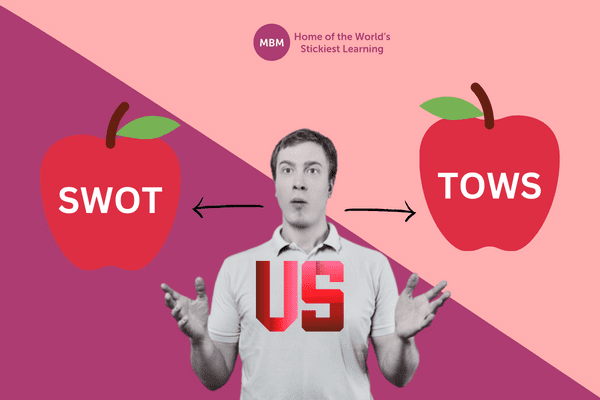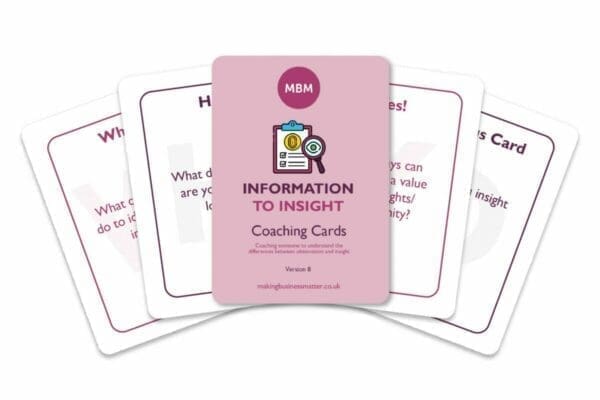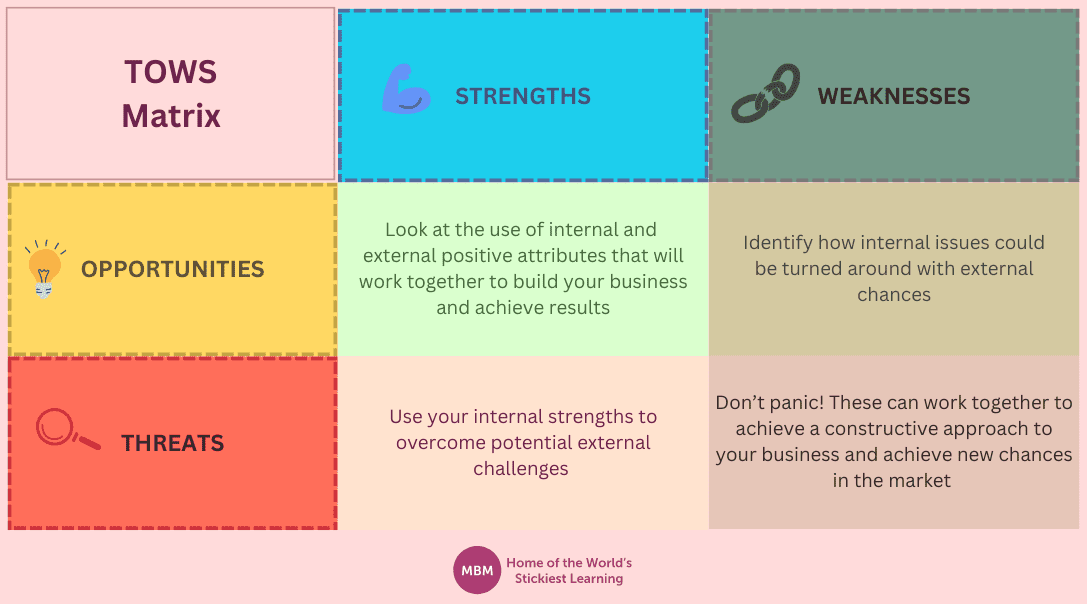Achieve Better Strategic Planning Results With Tows Matrix
You may be wondering, what is a TOWS Matrix? That is a great question that we are here to answer. We will be introducing you to the TOWS Matrix. Also, we will share the differences and similarities between the TOWS Matrix and a SWOT analysis. Next, we will cover the 4 main strategies of the TOWS Matrix. And finally, you will really have a clear understanding of how this tool can help you generate great results.
What is a TOWS Matrix?
To begin with, a TOWS Matrix stands for Threats, Opportunities, Weaknesses and Strengths Matrix. It is used in strategic planning. You use it to reduce threats from external forces while utilising external and internal opportunities and strengths to achieve more in the market. Also, one main purpose is to put a SWOT analysis into action.
TOWS analysis was introduced by Heinz Weirich back in 1982. It was featured in a paper named “The TOWS Matrix: A Tool for Situational Analysis”. Organisations of all sizes and from all industries have used this tool for more effective strategic planning. The tool may be 40+ years old. However, that doesn’t take away from its usefulness. In fact, when training my leadership programme, I introduced this to the participants along with the SWOT analysis. We were covering Strategic Planning at the time.
Let’s have a look at how they compare.
TOWS Matrix V’s SWOT Analysis

There are some similarities as well as differences between the TOWS Matrix and the SWOT analysis. Here, we will look at some of those elements.
Similarities:
Well, the first obvious similarity of these tools is the use of the 4 key focus areas. These are Strengths, Weaknesses, Opportunities and Threats.
Also, they are both strategic planning tools that teams use. They help teams look at internal and external factors that can impact your business and results.
Then, these tools can be used independently or as a team. They are great tools to use for brainstorming and group discussions. Also, they can help get the creative juices flowing for everyone involved.
Differences:
The main differences between the TOWS Matrix and SWOT analysis are the following:
First, the SWOT analysis allows you to list your data under the 4 different categories. However, the TOWS Matrix takes it a step further. Actually, it allows you to start putting your action plan together to move forward.
Next, the SWOT stays within its own categories. On the other hand, the TOWS Matrix is about merging the different categories to show how they interact with each other to get results.
Also, the TOWS Matrix puts its initial focus on external factors. The Threats and Opportunities come first. Whereas, the SWOT focuses first on the internal factors, the Strengths and Weaknesses.
Then, another difference is that the SWOT analysis is a planning tool, while the TOWS Matrix is more of an action tool.
Overlap:
The best thing about these 2 strategic planning tools is that they can work together. Basically, you need to have your SWOT analysis done before moving on to the TOWS Matrix.
First, conduct the SWOT analysis to identify the necessary data.
Next, use this data to fill the necessary fields in the TOWS Matrix.
Then, you can start your strategic action planning.

Read our return policy.
>> Information to Insights Coaching Cards <<
TOWS Matrix 4 Strategic Options
As we saw, the TOWS Matrix looks at Threats, Opportunities, Weaknesses, and Strengths. It looks at the process from an external vantage point as its main focus. But, what are these strategies that help make it efficient for strategic planning?
SO (Strengths/Opportunities)
Here, match the Strengths with the Opportunities that have been identified. You are combining the elements of your internal company strengths with your external opportunities. Really, it’s a win-win option. Pool all of your positives together to increase revenue or market share.
For example, you have a retail business that sells clothing. Your own company brand is a low-cost option. However, your closest competition doesn’t offer these options. This can be used in the wider market to benefit sales in comparison to your competitors.
WO (Weaknesses/Opportunities)
Next, we look at the collaboration between our internal weaknesses and external opportunities. You may be facing some internal issues that need resolving. However, potential external opportunities could help turn those weaknesses around.
Imagine you have staff who are currently in a slump in terms of motivation and morale. While conducting your SWOT, you recognise the external opportunity to create innovative products in the market. This can be used to re-energise your team, creating enthusiasm for something new.
ST (Strengths/Threats)
Now, let’s look at the next section. Here, we have a mix of internal strengths and external threats. So, we are using our team’s positive attributes to avoid potential external challenges.
For example, think of your marketing strategies. Here, we might identify strong connections with our customer base thanks to our team. This is an internal strength. However, we are facing fewer new customers coming on board via online apps. Here, we can use those attributes of our team to build on new customer relations online.
WT (Weaknesses/Threats)
Some may worry about this element, seeing it as the most challenging of the 4. However, using internal and external data can actually help us identify actionable progress.
So, we have…
Sample Matrix

How to Use the TOWS Matrix Effectively
Now, let’s look at how this all comes together for effective strategic planning.
A useful way to use the TOWS Matrix is to number the data identified in each of the SWOT sections. Next, cross-match the areas that will work best to create actionable steps. Then, create your action plan based on the results.
Here, we will look at a hypothetical company where the TOWS Matrix is being used to improve its strategic approach. For this example, our company will be in the retail industry.

So, you can see that by cross-referencing the ideas from the different sections, you can increase your options in putting a strategic action plan together. TOWS Matrix is about action rather than just analysis.
Other Strategic Tools
There are many tools out there that you can use for strategic planning, management and action. However, how do you know which one is right?
First, we looked at the TOWS Matrix and the SWOT analysis. Now, we will look at some other tools that we can compare the TOWS Matrix to in terms of use and efficiency. Here, we will look at 3 other tools. You can decide what works best for you and your needs. My personal recommendation is to use a combination of tools with the TOWS Matrix for the best results.
#1- The PESTEL Analysis
So, there is the PESTEL analysis that a lot of people like to use. PESTEL stands for:
- P – Political
- E – Economical
- S – Social
- T – Technological
- E – Environmental
- L – Legal
Benefits of the PESTEL Analysis
These can be great areas of focus for any company to use when developing a strategic action plan. They are all very relevant topics and can impact any industry at any time.
Limitations of the PESTEL Analysis
In comparison to the TOWS Matrix, PESTEL is more limited with the focus on only the external factors. Therefore, you miss out on the important internal factors that need addressing.
Also, the PESTEL analysis is more similar to the SWOT analysis. Meaning, it is useful for gathering data. However, it doesn’t include action solutions as the TOWS Matrix does.
#2- The Balanced Scorecard
I was lucky enough to use the Balanced Scorecard for a number of years in previous roles. It really is a very useful tool. Primarily, the Balanced Scorecard is a strategy performance management tool. It is used for tracking the progress of targets set for a specified time period, usually annually.
Benefits of the Balanced Scorecard
One of the main benefits of this tool is how easy it can be to use. Each of the 4 main sections is awarded a weight. This allows for a more balanced focus on business goals. These sections often include Finance, Customer, Process and People as their 4 key areas of focus.
Also, it serves as a great map of the strategic journey the company/department is planning to take. As each section has assigned goals, you can follow the map to prioritise your efforts.
Limitations of the Balanced Scorecard
One main limitation is ensuring that the proper targets have been identified. Many leaders use this tool without having done the proper analysis first. Therefore, their targets may not meet the company’s real needs.
Also, the Balanced Scorecard has very little focus on external focus areas. Therefore, the focus remains mostly internal. This is a big difference from the TOWS Matrix. Also, it is a major limitation in terms of business growth. Therefore, you will struggle when keeping up with the competition.
#3- Porter’s Five Forces
Here, we have another strategic tool. This time the tool focuses on 5 areas that greatly impact an entire industry. As such, it helps identify the competitive structure of the industry being analysed.
The 5 focus areas are:
- Existing rivalry with competitors.
- The threat of new entrants.
- Bargaining power of suppliers.
- Bargaining power of customers.
- The threat of substitute products.
Benefits of Porter’s Five Forces
First, this tool is great for getting an in-depth look at your industry and where you fit in the mix.
Also, the 5 sections really structure the areas of focus for the analysis. This gives those involved in the activity great structure when brainstorming.
Limitations of Porter’s Five Forces
Again, we see a tool that focuses only on external factors. Therefore, we see the important internal elements being overlooked. This can lead to limited strategic action moving forward.
Also, like SWOT, this is an analysis tool and misses the action steps. This is in contradiction to the TOWS Matrix.
Then, it can be difficult to use for businesses that overlap into different industries. When you have a wider business portfolio, this tool can be challenging to use.
Using the TOWS Matrix with I.D.E.A.

So, we have looked at what a TOWS Matrix is and how it works. We have even seen how it performs in comparison to other strategic tools out there. However, how can you apply it with greater ease? I suggest using I.D.E.A for best results.
INITIATE
Get the process started. There’s no point in waiting until the start of the year, start now. You can:
- Gather the team for a SWOT brainstorming session. (Perhaps 2-3 are needed!)
- Ensure all ideas for the SWOT analysis are given a chance for further review.
- Note all the ideas in the relevant sections.
- Make sure you have them in the right sections for later use.
DIVIDE
So, you have your SWOT complete, now the TOWS Matrix comes into play.
- Separate your SWOT ideas into workable action points.
- Number the ideas in each of the sections so they can be paired more easily.
EVALUATE
Next, start evaluating what could work well together. Here, you really need to get those ideas from the different sections working together.
- Compile your action plan.
- Agree on the action points with everyone involved.
- Ensure timeframes are set.
ACTION
Plans are great. It’s always important to have an effective action plan in place. However, action is necessary. Otherwise, it’s just words without impact.
- Get the team together and share the final action plan.
- Assign roles and responsibilities.
- Ensure everyone knows what is expected of them individually and as a team.
- Monitor progress.
- Support the team until the goals are achieved.
- If needed, adjust the action points along the way.
Wrap up
Having used the TOWS Matrix to set team goals, I can highly recommend it. The structure it creates with the variety of analysis and action steps is effective. Additionally, the team becomes more invested in the company goals when they actively participate in a process like this.
Found this article useful? Support by liking our articles on Medium.




